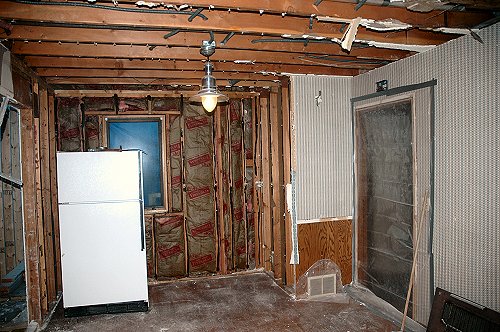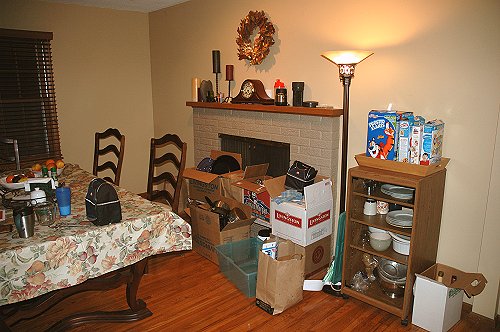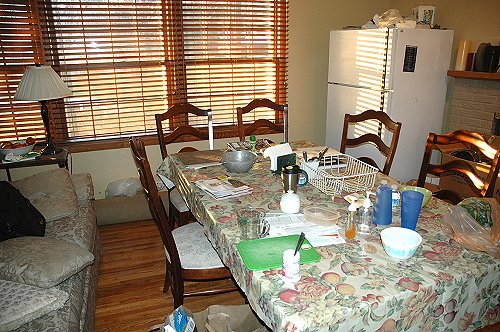Setting Up A Temporary Kitchen
Part 6 Of Our Real Life Remodeling Journey
Demolition #2 involved the kitchen and that meant establishing a location for a temporary kitchen. The saying that the kitchen is the hub of the home is no lie and its significance as a central part of daily life is reinforced when you no longer have it.
If you lose your kitchen during a remodel, finding a space for a temporary one becomes job #1. In our case we had two choices: we could move the kitchen to the finished half of the basement or into the living room which was adjacent to the existing kitchen.
The basement offered some advantages in that we have an extra (albeit old) refrigerator down there already. The laundry sink is there too which makes it convenient for cleaning the dishes. The problem is that our basement is already pulling duty as the stand-in family room.
One of the important things for us in this whole process was to have a place where we could go to escape the chaos of the remodeling. Maintaining the sanctity of the basement as a family room where we could relax was paramount so we opted to use the living room as the temporary kitchen.
Removing The Old Kitchen First
After the demolition of the family room, the kitchen was next. The cabinets came down as did the walls and ceiling. Some of the cabinets got a new lease on life in the garage. Their removal from the kitchen wasn't too difficult although anything more than a single wall cabinet really required two people for a safe extraction from the wall.
 Wall Cabinets & Peninsula Are Gone. . .
Wall Cabinets & Peninsula Are Gone. . .
 . . .Along With The Old Inoperable Range Hood
. . .Along With The Old Inoperable Range Hood
 The Drywall Comes Off Too
The Drywall Comes Off Too
Making Space
Before moving anything into the "new" kitchen we had to clear some space to accommodate the items to be relocated there. That meant moving some of the living room furniture to other places in the house.
The smaller chairs were reassigned to various bedrooms and the basement, as was the coffee table. We let the couch stay put because the the removal of the other furniture pieces afforded us enough space. We kept a narrow console table in place because it made a convenient location for the microwave and toaster oven.
Before embarking on this exercise we found it particularly helpful to stop and plan how this whole temporary kitchen setup was going to play out. We determined which items in the new space needed to be moved and where they would go. Likewise we thought about which items could stay and might be of use.
Moving Into The Temporary Kitchen
The next chore in setting up a temporary kitchen was packing up everything in the existing kitchen that we didn't absolutely need and finding some other place to store these items. You can read about that part of our effort in Part 3.
After that, we had to find an appropriate method, means and/or place to put the essentials in the new space. For example, we needed a spot for the food stuffs we use on a daily basis like cereals, breads, lunch items and the like. We also needed a spot for plates, bowls, cups, pots, pans and utensils.
 The Living Room As Our New Kitchen
The Living Room As Our New Kitchen
Items that we found helpful in establishing our ad hoc kitchen included a small, cheap pantry that originally housed a bunch of cookbooks and spices. We used that as our main pantry where most of the non-perishable food got stored. It's not big, roughly 2 feet wide by 4 feet tall, but it did the job without taking up a lot of room.
We also borrowed a few other items from around the house to use in place of things that were originally stored in the kitchen cabinets. We used two plastic bins that held unused toys and an old stand-up stereo cabinet to house our dishes and other essentials. If you don't have items like these around the house that you can press into service, you can purchase some cheap bins or shelving units to tide you over.
One other alternative that we employed as well was cardboard boxes. We found the ones from the liquor store to be pretty handy since they usually come with dividers to protect the liquor bottles. We used them to store glassware and things like cooking oil and vinegar bottles.
If you're planning on going through a similar type of remodel and need to relocate the kitchen, pare down as much as you can. Unless you live in a gymnasium, your temporary kitchen will get cluttered pretty quickly if you try and retain everything that was in your old kitchen.
A Place For Appliances & The Table
The third big piece in this effort was finding a place for the appliances. In our case, that meant the microwave, toaster oven and fridge. The refrigerator had wheels so it wasn't a big deal to move it into the living room.
We put our toaster oven and microwave on the console cabinet, tucked up against the wall. The spot was convenient and at a nice height too. If there's any way to locate these particular of appliances at countertop height, do so. It's a lot easier to use a microwave oven when you don't have to stoop down to floor level.
 Mission Control: Microwave, Toaster Oven, Pantry & Utensils
Mission Control: Microwave, Toaster Oven, Pantry & Utensils
Our old kitchen was disassembled in stages which meant we still had access to our electric cooktop and kitchen sink for a period of time which was a huge help. If possible I recommend negotiating with your contractor to work around these items until it's absolutely necessary to tear them out.
Our backup plan in the event this wasn't possible was to purchase a portable electric cooktop. They come in single and double-burner varieties and aren't that expensive. You can find them for $50 to $100. It's a small price to pay if you're losing your kitchen for a couple of months and compared to the cost of a full kitchen remodel, it's a drop in the bucket. Just be sure to follow the manufacturer's directions about locating it in the proper place to avoid a fire hazard.
The last thing to move into the temporary kitchen was the kitchen table. We made sure we removed enough furniture in the living room so that we'd have enough space for the table and chairs.
 A Little Cramped But Usable
A Little Cramped But Usable
Based on our experience the foundation for a successful temporary kitchen involves several key elements:
- A place to relocate the stand-in kitchen with adequate space to accommodate your needs
- Good planning ahead of time to determine where things will go, what's essential and what's not
- A pairing-down to just the items that are really needed (it's not like you're going to be baking cookies and entertaining guests during this time period)
- Provisioning with sufficient appliances to keep life bearable (a microwave, toaster oven, maybe a portable electric cooktop)
- Last but certainly not least, a bit of tolerance, for both the people you live with and the conditions you're living under
That last point is important because surviving any major disruption, particularly to your kitchen, changes all of your daily habits. You have to get used to knowing where the cereal is or where the forks and plates are. There's usually less physical room so you're in close quarters and will stumble over each other from time to time. That can put some stress on a family. But going into this with the knowledge that it's temporary combined with some good planning on the front end should hold you in good stead while you ride out your remodel in your temporary kitchen.
Here Are Links To The Other Stories In This Series:
Part 1 - Our Real Life Remodeling JourneyPart 2 - The Remodeling Contract
Part 3 - Getting Ready
Part 4 - Recycled Building Materials
Part 5 - The Demolition
Part 7 - Starting To Build - A Basement Or A Crawl Space?
Part 8 - Closing Up The Addition
Part 9 - Choosing The Granite Countertops
Part 10 - Sweat Equity
Part 11 - Electrical, Plumbing & HVAC
Part 12 - Dust, Dust & More Dust
Part 13 - Installing The Wood Floor
Part 14 - Getting Our Kitchen Back - Cabinets & Countertops
Part 15 - Installing The Stone Fireplace
Part 16 - The Completed Remodel Before And After

Publisher's Comments
The following story is part of a series of articles about my and my family's experience with our home's remodel. Links to the other stories are found at the bottom of the page.